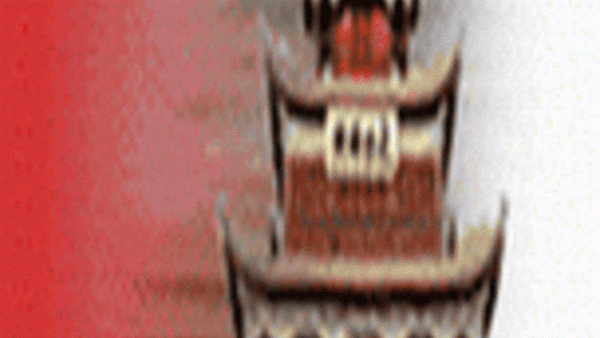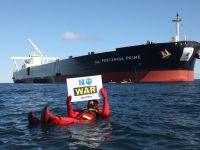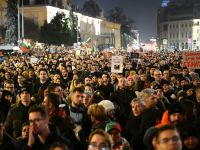Iran has reached an economic crossroads: Reform or fall further behind the rest of the world in providing its people with improved living standards. Twenty years after the Islamic Revolution, Iran's oil-dependent economy is stagnating and suffocating beneath billions of dollars of debt. Furthermore, Iranians are finding jobs harder to come by, and there are an increasing number of calls to implement reforms and seek membership in the World Trade Organization to rescue the country from this malaise. There are those, however, who oppose membership and such reforms, claiming that increased competitive pressure to improve local product quality to compete on a global scale is both unrealistic and dangerous. Iran's oil-incomes have forced the economy to be largely consumer-oriented. Experts argue that a shift away from this may be necessary, especially with the falling international oil prices, which have weakened Iran's hard currency income. Iran's economic "identity crisis" is further exacerbated by the ongoing power struggle between the country's conservative religious clerics and a more moderate generation of leaders. The outcome of the upcoming February elections, which will pit the two groups against one another, is expected to have a significant impact on the country's future economic course.
Economic Overview: How bad is the damage?
Dr. Nur-Bakhsh, the well-respected director of Iran's Central Bank, recently provided an optimistic picture of the Iranian economy saying that "the country is getting out of its position of stagnation and economic activity is beginning to flourish again" (Mashhad Khorasan, Dec. 99). Many experts, however, counter this projection, claiming it is based on misleading short-term data. They say the economy is actually suffering and that economic reform, is no longer a maybe, but a must.
Consider the following indicators:
* The country is currently ranked as the world's 66th most indebted nation. Some predict that today's $23 billion in foreign debt could explode to $100 billion in the next few years.
* Many Iranian manufacturers suffer from such extreme cash flow shortages that they are unable to sell their goods to local buyers (who have minimal buying power). The problem is further exacerbated by the falling trade turnover rates, that hinder banks from providing loans for such purchases.
* Iran's industrial sector growth rate has plummeted in the past year.
* The government's Third Development Plan predicts increasing unemployment from a current 13 percent to 15.3-16 percent of, 2.874 million Iranians.
* The rial, Iran's national currency, has decreased in foreign exchange value.
* There is also a widening income distribution gap.
If these problems, and others, are not resolved, the people will remain in a state of subsistence, struggling to pay loans and debts. And basic demographics spell trouble for Iran's future. Iran's population growth is expected to rise to 1.7 percent by the end of 2001, since 52 percent of the country's 63-million population are below 20 and will soon be reaching marriageable and child-bearing age.
Specters of Past Economic Decisions
Many of Iran's current economic problems are rooted in the past. Take the country's foreign debt as an example. At the outset of the war with Iraq, Iran was forced in 1980 to take a $4.5 billion loan. Though the government repaid the loan in 1991, total foreign loans skyrocketed the next year to $16 billion. Why the debt has grown so large so fast is debatable, but the following factors contributed:
* Discrimination between the public and private sectors
* Interest augmentation compounding the debt
* Excessive focus on import substitution rather than development of an effective export expansion program
* Volatile foreign currency exchange rates.
* Dangerous over-dependence on the oil industry to save the economy.
* Extreme inefficiency and "myopia" at the government level while formulating economic plans and utilizing foreign loans.
Reform
While experts may dispute the exact causes of the country's economic problems, most agree that the solution lies in reforms. Furthermore, the notion of seeking membership in the WTO is a hot topic, although it is not perceived as a panacea for Iran's economic challenges.
Acceptance to the WTO is a lengthy process that often requires a country to undergo many reforms before the organization will even consider the country. Iranian Deputy Minister, Hossein Naji, an ardent proponent of joining the WTO, said in January, "We should try to prepare the grounds in [Iran] to clear any obstacles to materialization of this goal in order not to face any problem after becoming a member state of this world body" (IRNA, Jan. 12, 2000). Various WTO benefits await Iran should it receive membership. WTO membership typically stimulates economic growth, provides more choice of products and qualities, raises trade incomes, and cuts the cost of living through freer trade
Reforms that the country would need to implement before acceptance include the following:
* Transform into a free-market economy.
* Reduce government control over agriculture as well as reduced tariffs on agricultural products
* Slash export subsidies
* Lessen tariffs on agricultural products.
* Reform the trade system to allow the country to succeed in the international markets as a member of the WTO.
* Reform the bureaucratic and legal systems
Iranian economists have also identified three main areas in which the country needs to begin immediate reform. The first is shifting to a more "export-based" economy. Building free zones to display products, such as those used in China to attract foreign investments, is one suggested method to facilitate this shift. Dr. Sabahi, professor of economics at Ferdowsi University in Mashhad, also suggests that imports must be decreased and replaced with domestic production that will both raise national income and reduce unemployment.
A second area that needs reform is productivity and efficiency, which are heading toward crisis levels. Experts contend that Iran's productive labor must increase if the debt is to be reduced or halted at its current amount. Furthermore, Iran needs to focus on improving product quality if it intends to secure international market share for its goods - something critical to being a WTO member. Evidence for the need to be efficient can be seen in Iran's suffering agricultural industry, where farmers often use traditional and out-dated farming equipment and methods, and lack effective planning skills.
A third area experts believe needs attention is the country's investments. The government, they argue, has to become smarter in its investments unlike in the past where it has, for example, used loan funds for government overhead.
The Path Ahead:
The Iranian economy indeed faces many questions - questions with no easy answers. The road to recovery is a long one. If Iran is to join the WTO, it must make a serious commitment to "shaping up" its economy. Nonetheless, the future of Iran's economy rests in the nation's ability to improve from within, regardless of WTO membership - and this can only be achieved if everyone - from the local farmers to the government officials - is willing to take an active and committed role. Thus far, experts largely agree that President Khatami's "quick-fix" attempts (i.e. reducing the number of foreign workers) to save the economy, have not been successful. A comprehensive and long-term plan is needed.
© 2000 Mena Report (www.menareport.com)







